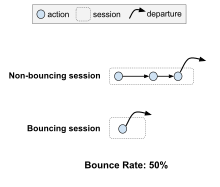Bounce rate
Bounce rate is a key figure from the field of web analytics . The German translation is bounce rate .
definition
The Digital Analytics Association (WAA) defines the bounce rate as the percentage of website visits with just a single page view. According to Avinash Kaushik (2007, pp. 168–170), bounce visits also include short visits of 5 to 10 seconds. A short visit means that visitors to the website are no longer motivated to delve deeper into what the website has to offer. The analysis of the bounce rate provides important information for optimizing the website. An expanded definition of the bounce rate, according to Yehoshua Coren, is the percentage of sessions with a single interaction in relation to all sessions. These interactions include page views, but, as with Google Analytics, these interactions can include so-called event hits or e-commerce transaction hits, which then reduce the bounce rate when triggered.
Optimization of marketing, homepage and top entry pages
By analyzing the sources for the data traffic (see also referrer ), a web analytics tool shows where the visitors come from. For example, visitors can come to the website via search engine marketing . The analysis of the bounce rate then shows how successful individual advertising campaigns (e.g. paid search words) are.
Benchmarks: level of the bounce rate
It is not easy to answer what a good or bad bounce rate is and it also depends on the purpose of the website and the respective industry . For example, Google Analytics provides a comparison using the benchmark report. Basically, one can say that a bounce rate of 50% needs to be considered more closely (Aden, p. 192).
Beck (2008, p. 332) points out that the bounce rate for Google Ads landing pages is usually higher than for other pages because the visitors are new visitors. Pages with a high information content also tend to have a higher bounce rate than other pages, since many visitors also find access here via a search engine (Hassler, 2008, p. 229). Well-known brands usually have lower bounce rates, as many users land on the start page via direct input and almost always generate another page view from there.
literature
- Marco Hassler: Web Analytics . Evaluate metrics, understand visitor behavior, optimize website . Mitp-Verlag, 2008, ISBN 978-3-8266-5931-7 , p. 229 .
- Alexander Beck: Google AdWords . Mitp-Verlag, 2008, ISBN 978-3-8266-5905-8 , pp. 332 .
- Avinash Kaushik: Web Analytics . An hour a day . Sybex, 2007, ISBN 0-470-13065-2 , pp. 168-170 (English).
- Timo Aden: Google Analytics . To implement. Interpret. Benefit . Hanser-Verlag, 2009, ISBN 978-3-446-41905-6 , p. 192-193 .
